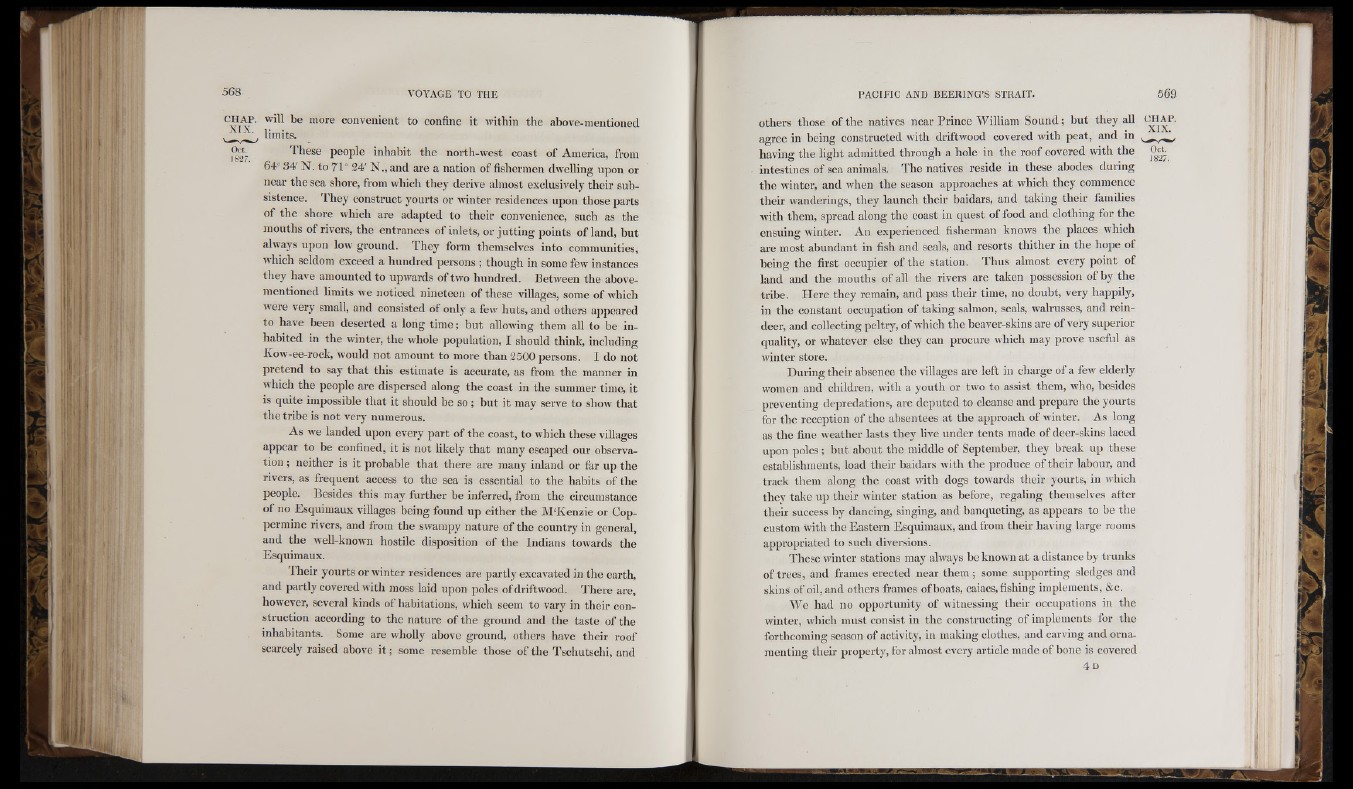
will be more convenient to confine it within the above-mentioned
, limits.
These people inhabit the north-west coast of America, from
64° 34' N . to 71° 24' N., and are a nation of fishermen dwelling upon or
near the sea shore, from which they derive almost exclusively their subsistence.
They construct yourts or winter residences upon those parts
of the shore which are adapted to their convenience, such as the
mouths of rivers, the entrances of inlets, or jutting points of land, but
always upon low ground. They form themselves into communities,
which seldom exceed a hundred persons ; though in some few instances
they have amounted to upwards of two hundred. Between the above-
mentioned hmits we noticed nineteen of these viUages, some of which
were very small, and consisted of only a few huts, and others appeared
to have been deserted a long time; but allowing them all to be inhabited
in the winter, the whole population, I should think, including
Kow-ee-rock, would not amount to more than 2500 persons. I do not
pretend to say that this estimate is accurate, as from the manner in
which the people are dispersed along the coast in the summer time, it
is quite impossible that it should be so ; but it may serve to show that
the tribe is not very numerous.
As we landed upon every part of the coast, to which these villages
appear to be confined, it is not likely that many escaped our observation
; neither is it probable that there are many inland or far up the
rivers, as frequent access to the sea is essential to the habits of the
people. Besides this may further be inferred, from the circumstance
of no Esquimaux villages being found up either the M'Kenzie or Coppermine
rivers, and from the swampy nature of the country in general,
and the well-known hostile disposition of the Indians towards the
Esquimaux.
'I'heir yourts or winter residences are partly excavated in the earth,
and partly covered with moss laid upon poles of driftwood. There are,
however, several kinds of habitations, which seem to vary in their construction
according to the nature of the ground and the taste of the
inhabitants. Some are w'holly above ground, others have their roof
scarcely raised above i t ; some resemble those of the Tschutschi, and
Others those of the natives near Prince William Sound ; but they all ‘"HAP-
agree in being constructed with driftwood covered with peat, and in ^
having the light admitted through a hole in the roof covered with the
Oct.
1827.
intestines of sea animals. The natives reside in these abodes during
the winter, and when the season approaches at which they commence
their wanderings, they launch their baidars, and taking their families
with them, spread along the coast in quest of food and clothing for the
ensuing winter. An experienced fisherman knows the places which
are most abundant in fish and seals, and resorts thither in the hope of
being the first occupier of tlie station. Thus almost every point of
land and the mouths of all the rivers are taken possession of by the
tribe. Here they remain, and pass their time, no doubt, very happily,
in the constant occupation of taking salmon, seals, walrusses, and reindeer,
and collecting peltry, of w'hich the beaver-skins are of very superior
quality, or w'hatever else they can procure which may prove useful as
winter store.
During their absence the villages are left in charge of a few elderly
w'omen and children, with a youth or tw'o to assist them, who, besides
preventing depredations, are deputed to cleanse and prepare the yourts
for the reception of the absentees at the approach of winter. As long
as the fine weather lasts they live under tents made of deer-skins laced
upon poles ; but ahout the middle of September, they break up these
establishments, load their baidars with the produce of their labour, and
track them along the coast with dogs towards their yourts, in which
they take up their winter station as before, regaling themselves after
their success by dancing, singing, and banqueting, as appears to be the
custom with the Eastern Esquimaux, and from their having large rooms
appropriated to such diversions.
These winter stations may alw'ays be known at a distance by trunks
of trees, and frames erected near them ; some supporting sledges and
skins of oil, and others frames of boats, caiacs, fishing implements, &c.
AA’e had no opportunity of w'itnessing their occupations iu the
winter, wliich must consist in the constructing of implements for the
forthcoming season of activity, in making clothes, and carving and ornamenting
their property, for almost every article made of bone is covered
4 D